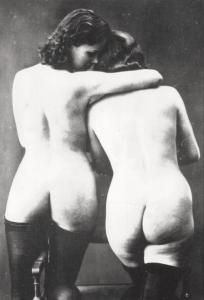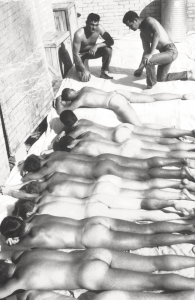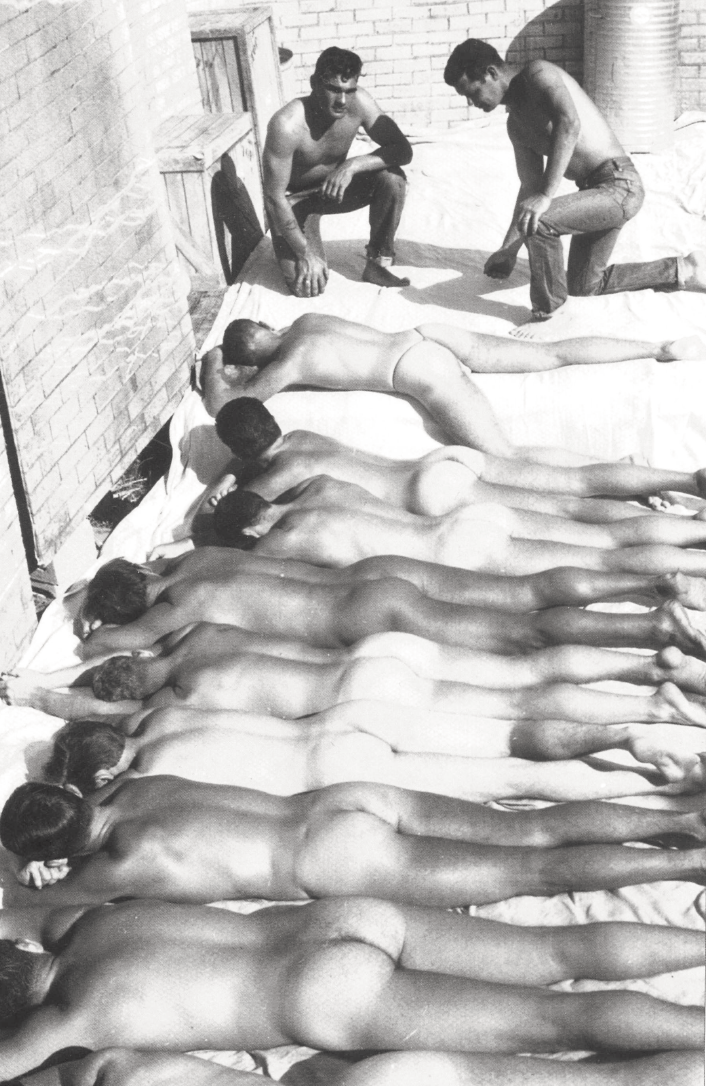CAN THE TERMS “museum” and “sex” legitimately be put together in one descriptive title? The New York State Board of Regents, which controls access to the official Empire State moniker of “Museum” (and, not insignificantly, to the nonprofit status that accompanies state sanctification as a cultural organization), says they cannot. To the Regents, the very title “Museum of Sex” defames and ridicules the hallowed notion of museumhood.
Daniel Gluck and Grady Turner, executive director and curator respectively of New York City’s spanking new, elegant (if non-state-approved) Museum of Sex, disagree. What could be more appropriate, they argue, than having an institution whose exhibits honor sex as an important, complex, and variegated aspect of life, worthy of the most thoughtful investigation, reflection, and celebration—like art, like history, like a dozen different ethnicities, like baseball—like so many cherished aspects of culture that we enthusiastically acknowledge in this way?
“The mission of the Museum of Sex,” they announce after four years and millions of dollars of preparation, “is to preserve and present the history, evolution, and cultural significance of human sexuality,” while bringing the public “the best in current scholarship” on sexual issues. It is in this spirit that the Museum’s 15,000-square-foot inaugural exhibition, “NYC Sex: How New York City Transformed Sex in America,” seeks to “guide visitors through a detailed history of the city’s sexual subcultures from 1825 to the present.” The exhibit emphasizes the cyclical ways that burgeoning and changing sexual practices and proclivities have repeatedly overwhelmed and been overwhelmed by forces of sexual repression and control. It also shows how the cauldron of New York’s dense and diverse mix of sexual populations and desires has repeatedly spawned forms of sexual exploration and experimentation that went on to shape the sexual development and sophistication of the nation as a whole.

To be sure, MoSex (as Museum of Sex people affectionately refer to their creation) is not the only sex museum in the world. Amsterdam and Barcelona each has one, but these are little more than garish tourist attractions, kitschy expressions of the dominant culture’s titillation and trivialization of sex. MoSex is the first attempt in decades—probably since the demise of San Francisco’s short-lived International Museum of Erotic Art during the early 1970’s—to bring the respect and thoughtfulness associated with serious museums to the subject of sex.
It’s no accident that the primary lens through which MoSex views sex is that of history rather than art. Daniel Gluck, its founder, chief financial backer, and executive director, feels that the image that erotic art raises in people’s minds is essentially cheesy. While shopping for the right person to become MoSex’s chief curator, he came across Grady Turner, then director of exhibitions at the New-York Historical Society. Turner was fascinated by the idea of making a museum of sex work effectively—of walking the fine line between education and entertainment, controversy and legitimacy, that would be needed to bring the concepts “museum” and “sex” together. Turner was no stranger to controversy. At the Historical Society he curated the much criticized, emotionally unnerving, and ultimately very successful exhibit, “Without Sanctuary: Lynching Photography in America,” a collection of photographs that frankly documented an aspect of American history that most people would rather sweep under the carpet.

Turner’s primary goal for “NYC Sex” is to use a wide array of collected historical objects to convey the personal sexual stories of a variety of people. His primary interest is social history—that of ordinary people as opposed to the rich and powerful. While much of “NYC Sex” commemorates the contributions of major figures in sexual history—birth control advocate Margaret Sanger, anti-vice crusader Anthony Comstock, condom mogul Julius Schmid, pin-up artist Alberto Vargas, to name a few—Turner also wanted to get beyond exemplary sexual pioneers to tell the stories of common people. And he was committed to presenting a broad spectrum of stories that would acknowledge the great diversity of sexual activity, much of it decidedly outside whatever was considered mainstream at the time. Prostitution, pornography, the emergence of gay and lesbian culture, the manufacture and subterranean distribution of bondage devices, radical sex clubs of the 1970’s—each plays a significant role in the 170-year tour of New York’s sexual history that “NYC Sex” provides.
Turner is careful to note that the Museum is not an advocacy organization. Its intention is to offer objective information about sexual history, rather than to take a political position on abortion, birth control, obscenity, homosexuality, and so on. Inevitably, though, there is a powerful political message in the simple act of making information public that has traditionally been kept secret—whether the topic is sex or lynching. MoSex is important and controversial not just because it speaks of sex, but because it speaks of it in ways that some cultural gatekeepers are determined to forbid. Despite what the moralists would have us believe, for example, sexual practices have never been limited to the straight and narrow, as it were, as the “NYC Sex” exhibit makes abundantly clear. The exhibit demonstrates that unconventional sex has always found its way around whatever social constraints have been imposed to keep it from being practiced.
It’s a story that is particularly relevant as this nation plunges into yet another period of increasing sexual repression and fear. We’ve been here before, “NYC Sex” implicitly counsels, and there are lessons to be learned from the past. What disturbs the anti-sex crowd this time is not only the exhibit’s straightforwardness about sex but the fact that MoSex is laying claim to social respectability through its deliberately scholarly and thoughtful approach. William Donohue, president of the Catholic League for Religious and Civil Rights, condemned MoSex for what he called its “unabashed celebration of unbounded sexuality” and its “moral pollution”—before the museum had even opened its doors!
Where does one go to find historical objects to document and illustrate the underground sexual subcultures that have dotted New York’s landscape for the past 170 years? Turner sensibly turned to the people who are the most obsessed with those subcultures, namely anti-vice crusaders such as Anthony Comstock. Just as the voluminous report of the Meese Commission offered a virtual treasure trove of pornographic material to the public at government expense, and just as the public fuss of the Clinton-Lewinsky caper brought discussion of oral sex and the sexual uses of cigars to the dinner tables of the American heartland, so Anthony Comstock’s painstaking efforts to combat smut had the effect of elaborately recording the details and preserving the artifacts of underground sexual activity for posterity. As Comstock bulkily rolls over in his grave, his work is now the fodder for the educational efforts of sexual historians like Grady Turner. Material confiscated and archived by the New York Police Department in its various vice raids provided another ironic and valuable collection of source material for MoSex. In addition, the vast, meticulously catalogued personal porn collection of retired Library of Congress librarian Ralph Wittington, which he acquired over a thirty-year period at a cost of over $100,000, was recently purchased by MoSex when it outgrew even his ample home.
Artists and photographers, as well as historians, who address sex in other than titillating and sensational ways have always found it difficult to have their work taken seriously. As the forces of sexual repression have increased their political clout in the past twenty years, as the Ashcroft Justice Department contrives to limit the public availability of sex-related information and material, the world of fine art has become more reluctant than ever to embrace material of a sexual nature, no matter how thoughtful or artistic its intent and presentation. Respected galleries and museums that began to explore sexual themes during the 1970’s have grown increasingly reluctant to put their reputations on the media chopping block in recent years. Photography critic and commentator A.D. Coleman, who has written extensively on this subject for decades, notes that the existence of the new Museum of Sex, together with the publicity that its opening has generated, may encourage museums, galleries, and art publishers to be more open to sex as a subject for serious artistic representation.
Happily, the initial coverage of MoSex in the mainstream media has been remarkably respectful, if not entirely free of sniggering. Karin Lipson, writing in Newsday, acknowledges the museum’s “seriousness of purpose,” noting that “nothing at MoSex is presented in a tacky or cheesy fashion.” Maria Puente asks in USA Today (“Sex Scores Its Own Museum in the City—Exhibits Take Erudite Peek at the Erotic”), “[W]hy not [have]a museum that attempts to take a scholarly yet playful look” at sex, predicting that viewers will be intrigued, moved, and only a little titillated by the opening exhibit. Simon Tait notes in The London Times that MoSex “has gone some way to being taken seriously” by contracting the design of the first exhibit to the noted architectural firm of Casson Mann. A rather infantile article by Clyde Haberman in The New York Times entitled “Dirty Photos? Call them Artifacts” was balanced by a more thoughtful one by Ralph Blumenthal called “Sex Museum Says It’s Here to Educate.”
After a series of unfortunate construction delays, the long-awaited Museum of Sex opened its doors on October 5, 2002. The critics will have their say; the public will vote with their feet and their dollars. Whether MoSex will attract the 100,000 visitors it projects for its first ten months remains to be seen. But the emergence of a serious museum focusing on sex is a significant development in itself, an institution that this writer hopes will be around to honor and teach about sex for years to come.
The Museum of Sex is located at 233 Fifth Ave. at 27th Street. Hours are Sunday, Monday, Tuesday and Thursday, 10 a.m. to 6:30 p.m.; Friday and Saturday, 10 a.m. to 9 p.m.; closed Wednesdays. Tickets ($17 including audio tour) available at 866-MOSEXTIX. No one under 18 admitted. Additional information available at www.museumofsex.com. “NYC Sex: How New York City Transformed Sex in America” will be on display through July 3, 2003.
An elegant catalog of the show, edited by Grady Turner and also titled NYC Sex: How New York City Transformed Sex in America (Scala Books, 224 pages, $25.), includes chapters on “Sodom on the Hudson,” “Queers,” “Whores,” “Underground,” and “Porn,” and conversations with several members of the Museum’s Advisory Board, including Martin Duberman, Joan Nestle, Timothy J. Gilfoyle, Xaviera Hollander, Tracy Quan, Karen Finley, Art Spiegelman, and Annie Sprinkle.
David Steinberg writes a regular column on sexual issues that can be found at www.sexuality.org/l/davids/en.html.






